2010 October
About Andrew Cusack
 Writer, web designer, etc.; born in New York; educated in Argentina, Scotland, and South Africa; now based in London.
Writer, web designer, etc.; born in New York; educated in Argentina, Scotland, and South Africa; now based in London. read more
News
Blogs
Reviews & Periodicals
Arts & Design
World
France
Mitteleuropa
Knickerbockers
Argentina
The Levant
Africa
Cape of Good Hope
Netherlands
Scandinavia
Québec
India
Muscovy
Germany
Academica
Imperial Mexico
The Forgotten Monarchs that Shaped a Great Nation
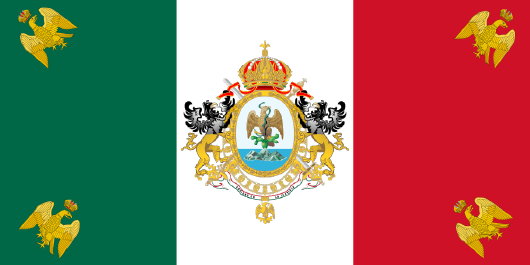
THE NEW WORLD has such a republican reputation these days. Even though there remain thirteen monarchies in the Americas, concentrated in the Caribbean, there are only three monarchs between them (all, curiously, women: Elizabeth II, Beatrix, and Margrethe II). But it’s usually forgotten that the Americas have had two great empires of their own: the Empire of Brazil in South America and the Empire of Mexico in North America.
Napoleon’s Peninsular War in Spain had caused quite a ruckus in the Spanish Americas, where liberals had seized the opportunity to wage long, rebellious wars of independence with fluctuating levels of popular support. In Mexico, two of the rebel generals, Agustín de Iturbide and Vicente Guerrero composed a plan to change the balance of power in the Spanish empire as a whole while simultaneously securing Mexican independence. The three main aims of the ‘Plan of Iguala’ were: 1) Catholicism as the established religion, 2) The independence of Mexico, and 3) The end of legal distinctions between the races; summed up as “Religión, Independencia, y Unión”.
But the larger scheme of the Plan was to convince King Ferdinand VII to move to Mexico and become Emperor of Mexico, shifting the center of power in the Spanish empire from Madrid to Mexico City. If Ferdinand would not accept, then the crown would be offered to his brother and the rest of his family down the line until someone accepted, or if even that failed then to a member of another European dynasty. (more…)
¡Viva México!
The Cry of Independence
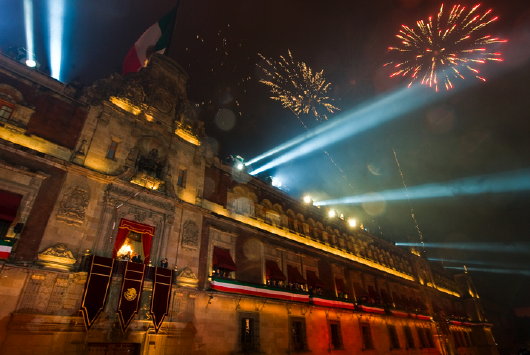
ONE OF THE established rituals of Mexico’s remembrance of her fight for independence is the Grito or “Cry of Independence”. Around eleven o’clock in the evening on the night of September 15th, the President of Mexico rings the bell of the National Palace on the Zócalo square in the center of Mexico City. The head of state hails the names of the leaders of the country’s independence struggle before shouting a threefold ¡Viva Mexico! Then, as the crowd in the plaza below goes wild, the President rings the bell again, waves the Mexican flag for all to see, and the national anthem is sung:
Gird, oh Fatherland, your brow with olive
by the divine archangel of peace,
for in heaven your eternal destiny
was written by the finger of God!
The whole thing has a strange buoyant solemnity about it, a splendid civic ritual set in the baroque surrounds of the old palace — it almost reminds one of the joyous Habemus papam from the balcony of St. Peter’s after the election of a pontiff. (more…)
Brown 26, Yale 14
B.U.R.F.C. 1st XV v. Y.U.R.F.C. 1st XV

I never paid much attention to rugby before I lived in South Africa, where it is inescapable, especially since I was studying at Stellenbosch, which the rugby-est of rugby universities. After becoming a rugby spectator you cannot go back to watching American football, which, with its stopping and starting, suddenly has the feeling of being a demented child’s game. And so, across the Connecticut border to trusty old New Haven, to join some friends and fellow club-members for some Saturday afternoon rugby and revelry, with champagne, whiskey, and home-brewed porter on offer. (more…)
Popping in to the Yale Daily News
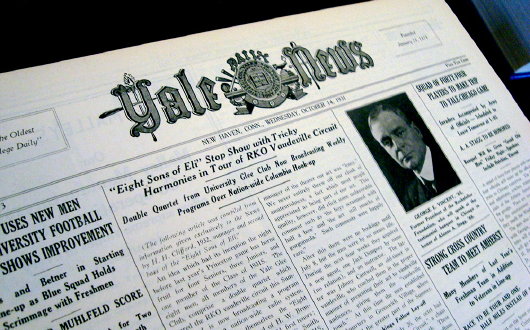
With a bit of time to spare between the rugby match and dinner, we discovered a friend of ours was exploring the newly renovated headquarters of the Yale Daily News and were invited to join in. The handsome gothic structure is now overshadowed by an ugly extension to the previously ugly Yale School of Architecture, widely believed to be the ugliest building in town. Henry Luce paid for the YDN building out of his own pocket in memory of his Yale classmate Briton Hadden, who died just 31 years old. The place went up in 1932 and underwent a multi-million-dollar renovation over the summer, and the place was looking good. (more…)
Mexico’s Military Parade

SIX-HUNDRED TROOPS, seventeen countries, field dress, full dress, and everything in between: the military parade to mark Mexico’s bicentennial was a remarkable sight to see. The parade moved down the Paseo de la Reforma, originally the Paseo de la Emperatriz, or Promenade of the Empress. The seven-and-a-half-mile-long boulevard was built on the orders of Maximilian I, Emperor of Mexico and was modelled after the Champs-Élysées in Paris and the Ringstrasse in Vienna. It stretches from the Zócalo square at the center of the city (where the Cathedral and National Palace are) to the Chapultepec Castle, the imperial residence during the Second Mexican Empire. (more…)
A Festive Flotilla
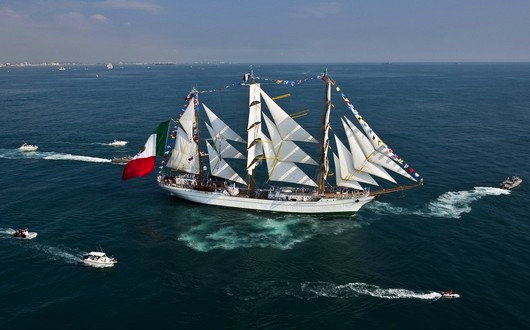
A great flotilla of tall ships from twelve countries set sail from Rio de Janiero on February 7th of this year for a months-long regatta to commemorate the bicentennial year of Mexico, Chile, and other Latin American countries. After departing Rio, “Sails of South America 2010” called in at Buenos Aires, Ushuaia, Punta Arenas, Valparaíso, and other points before finishing in Veracruz, Mexico in time for the commencement of the Mexican bicentennial in September.
ARM Cuauhtémoc (above), the training ship of the Mexican Navy, is a steel-hulled barque built in Bilbao in 1982. (more…)
A Miscellany of Mexican Music
Juan Gutiérrez de Padilla was born in Malaga, Spain in 1590 but moved to New Spain in 1620, and was appointed choirmaster of Puebla Cathedral in 1628. His corpus is massive, with over 700 works surviving. His Stabat Mater is above, but you should also hear his Missa ego flos campi. (more…)
Dodgy ‘knighthood’ for a dodgy lady
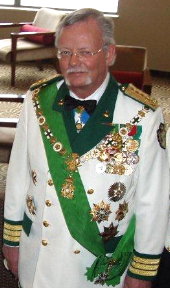
An example of the ‘Lazarus bling’, more medals than you can shake a stick at.
From the blog of John Smeaton we read that the former Irish president (and genial enemy of all that is good and holy) Mary Robinson has received a ‘knighthood’. Last month she was invested as a Dame in the self-styled ‘Order of St. Lazarus’, a fake order of knighthood. The group claims links to the old Order of St. Lazarus of which the last remnants faded away in the 1780s.
The current ‘Order’ was founded as a fake order of knighthood in 1910 by the confidence trickster Jean-Joseph Moser, and has grown by perhaps surprising leaps and bounds in the past few decades, taking into account P. T. Barnum’s famous maxim about a sucker being born every minute. The group has split into various factions and it has become notorious for having members in its ranks who don more metal “bling” than rap stars or Soviet generals.
The so-called Order of St. Lazarus exists throughout Europe and the Spanish- and English-speaking countries abroad, including the United States. The French branch of St. Lazarus was forced by the Grand Chancellor of the Legion of Honour to cease claiming to be an ‘order’, and members of the Order of Malta are forbidden from participating in St. Lazarus’s activities.
“The Order’s pretensions have been strongly condemned by the Holy See as aiming to replace ‘the legitimate forms of chivalric awards’,” according to Guy Stair Sainty, the acknowledged expert on these somewhat arcane affairs. Nonetheless, Guy points out that “supporters of Saint Lazarus include the heads of a handful of great noble families and, over the years, several leading Churchmen and Cardinals”.
“The Order of Saint Lazarus, although it is to be complimented for its considerable charitable efforts (notably in Germany), need not pretend to an historical continuity to which its claims, at the very least, are unsubstantiated,” Guy Stair Sainty concludes. “Were it to assume the character of a private association, founded in 1910, to emulate the traditions of the ancient crusader Order, it could deflect much of the hostility it has attracted… It would be much more successful and be more readily welcomed into the wider community of international humanitarian bodies, however, if it was to permit an honest appraisal of its origins.”
Ciudad de México
The Greatest City of the Americas
WITH A population of 20,000,000 people, Mexico City is the greatest city in the Americas — Tokyo and Seoul are the only metropolitan areas in the world that can claim a higher count of inhabitants. The old city of Tenochtitlan was founded by the Aztecs in the middle of a lake, 7,000 feet above sea level in 1325. According to legend, Huitzilopochtli — the Zeus or Jupiter of the Aztecs — indicated the site of the new capital through an eagle perched on a cactus with a snake in its beak. The city grew as the Aztec Empire augmented in size and strength, conquering hundreds of smaller surrounding tribes, enslaving their members, and offering their prisoners as human sacrifices. With great ceremony, vast numbers of prisoners were led one-by-one to the summit of the temples, where the priest would carve the living victim’s chest open with a blade of obsidian or jade, remove the still-beating heart and offer it to the appropriate god while the victim’s body was thrown down the steps of the temple. During the re-consecration of the city’s Great Temple in 1487, the Aztecs claim to have sacrificed 80,400 prisoners over the course of four days. It is not hard to imagine the relief of the conquered tribes when their liberation came at the hands of the Spanish. (more…)
The House of Moctezuma
Noble Descendants of the Aztec Emperor
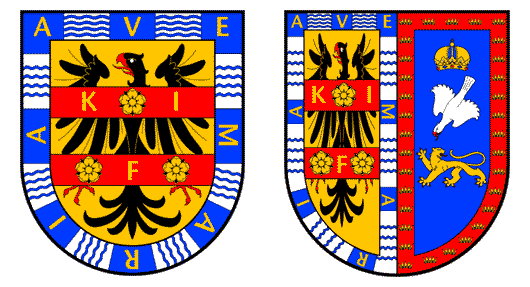
The last Emperor of the Aztecs, Moctezuma II (usually anglicised as ‘Montezuma’) suffered an ignominious end: defeated by the Spanish, some accounts have him being stoned by his former subjects, while others claim he died of starvation, refusing to eat food not worthy of an emperor, still more claim Cortés had him killed. Many of his descendants embraced Christianity and found favour from Mexico’s new overlord, the King of Spain. (more…)
Mexico Week
Over the course of this week our little corner of the web will feature a series of posts relating to Mexico, the great American nation which this year commemorates the two-hundredth anniversary of the beginning of its war of independence. That revolt was begun by a heretic priest, Miguel Hidalgo, under the influence of the contemptible ideas of “the Enlightenment”, but he nonetheless marched under the banner of the Blessed Virgin of Guadalupe, who is venerated to this day as Queen of Mexico and Empress of the Americas. This curious rebel presaged so much of the history of Mexico: rebellion and devotion, religion and irreligion.
Our ‘Mexico Week’ is not intended to give any sanction to rebel priests or violent revolt against legitimate authority, but we instead aim to take this opportunity to display to readers some of the greatness of this brilliant yet troubled nation, oft forgotten due to its rather famous and prominent neighbour to the north.
Growing up in the United States, as I did, Mexico was (and still is) often written off as a place of drug killings and drunk American college students. But digging beneath the surface one easily discovers a Mexico rich in story. ‘Mexico Week’ will by no means be a comprehensive survey of the country, its history, and traditions, but rather a little cabinet of curiosities, a Mexican miscellany if you will.
ora pro nobis!
Burma’s New Flag


Burma Colony (1937–1948)

State of Burma (1943–1945)

Union of Burma (1948–1974)

Socialist Republic of the Union of Burma (1974–1988) and Union of Myanmar (1988–2010)
The military government of Burma (officially ‘Myanmar’) unveiled a new flag for the southeast-Asian country last week. The new design (above) rejects the general form of Burmese national flags since the country was granted independence from Great Britain in 1948, but instead harkens back to the ‘State of Burma’, a puppet regime set up by the Japanese to integrate Burma into their ‘Greater East Asia Co-Prosperity Sphere’.
Somewhat paradoxically, the Minister of Defence in the puppet ‘State of Burma’ was General Aung Sang, the father of Aung Sang Suu Kyi, pro-democracy activist and winner of the Nobel Peace Prize. Aung Sang Suu Kyi is the most prominent leader of the opposition to the military junta that rules Burma, and has spent fourteen of the past twenty years either in jail or under house arrest.
The flag change is part of a transition period devised by the military junta in their attempt to reform the country into a managed democracy that will be less isolated from the rest of the world without threatening the junta’s grasp on power.
Burma became a British possession in 1824, and was made a province of the Empire of India in 1886. In 1937 the province was separated from India, excluding it from the reforms aimed at eventually granting dominion status to the sub-continent but also introducing important reforms for Burma, including an elected assembly with a prime minister. The country saw some of the heaviest fighting during the Second World War, but the forces of the Japanese puppet regime, the ‘State of Burma’ eventually saw the tide turning against the Empire of Japan and switched sides to join the British and Indian armies under Lord Mountbatten.
Charles of Austria
TODAY IS THE first feast of Blessed Charles since the announcement last December that the cause for the canonisation of his wife, Zita of Bourbon-Parma, has been opened as well. In an age when most people in government and public leadership seem barely even decent, let alone saints, it is all the more important to seek the prayers and intercession of Charles and Zita — husband and wife, mother and father, Emperor and Empress — for the preservation of peace, the prevention of war, and the renovation of our families as well as our societies at large. (more…)
A Forgotten Architectural Fantasist
Wilhelm Cornelis Bauer of the Netherlands
Boullée isn’t the only architect known more for the designs never built than for those that were. Wilhelm Cornelis Bauer (1862–1904) was a Dutch architect with a flair for the fantastic. He was born into an aesthetically minded environment in the Hague, where his father ran an interior decoration firm; his brother, the painter and engraver Marius Bauer, is better known. W.C. Bauer (sometimes known as Willem) studied at the Craft School before heading to the Royal Academy of Visual Arts and became involved in the circle of Dutch architects that included Berlage, Walenkamp, Kromhout and others.
Bauer had a very high opinion of himself, being convinced of his own genius, which often brought him into conflict with others, including potential patrons. The buildings of his that were constructed (such as a handful of houses in Bussum) were within the reasonable bounds of the Dutch contemporary vernacular, but Bauer was an inveterate dreamer with elaborate visions. Architectural competitions proved a perpetual draw, and while Bauer’s designs were often commended as highly artistic they usual brought simultaneous comments about impracticability. (more…)
Preservation is Not Enough
A Proposal for Enhancement
IT IS COMMONLY said of St Andrews that it is a place of beauty. This is often a compliment to its natural setting, with open skies arcing over the reaches of the bay, and ancient rock and cliff yielding to the changing rhythms of the waves. At the same time visitors are generally struck by the pleasing combination of natural and built environments: the ruined grandeur of the Cathedral and Priory standing bare to the elements; crowstep-gabled cottages gathered in against the wind; the broad thoroughfares interlinked with narrow cobbled lanes; and the church towers etched against the sky. There is also the scholarly dignity of Deans Court, the quizzical posture of the Roundel, the charm of the courtyards to the south of South Street, the sad ruination of Blackfriars juxtaposed with the aspiring frontage of Madras College, and other evocative sights besides.
Here and there within the midst of all of this stands, physically, historically, and socially, the University. Its contributions to the architectural distinction of the old town are obvious enough. They are, principally, the harmonious South Street complex of St Mary’s College (1593-41) to the west, Parliament Hall (1612-43) to the north, and the Library extension (1889-1959) – now the Psychology wing – to the east; and the North Street set of the Collegiate Church of St Salvator, Gate Tower and tenement (1450-60), and beyond it the west block (1683-90) containing the Hebdomadar’s Room, and to the east and north the College buildings (1829-31 and 1845-6, respectively). There are other smaller and oft-reworked jewels associated within the University: St John’s House in South Street (15th, 17th, 18th, 19th, and 20th centuries), St Leonard’s Chapel (remodelled c. 1512), and the ‘Admirable Crichton’s House’ (16th century), but the principal architectural benefactions of the University to the town are the North and South Street college complexes. I have not mentioned the Younger Graduation Hall (1923-9) and the Student Union (1972) and prefer to leave it for readers to determine what might be said of these.
It could hardly have passed unnoticed that the list of contributions dates mostly from the late middle-ages to the nineteenth century, and this fact raises two questions: first, whether in the second half of the twentieth century the University was sufficiently attentive to its role as principal architectural patron; and second, how it might now hope to enhance the built environment of St Andrews. (more…)
Fellowes Prynne in Johannesburg
A Rejected Proposal for St. Mary’s Anglican Church
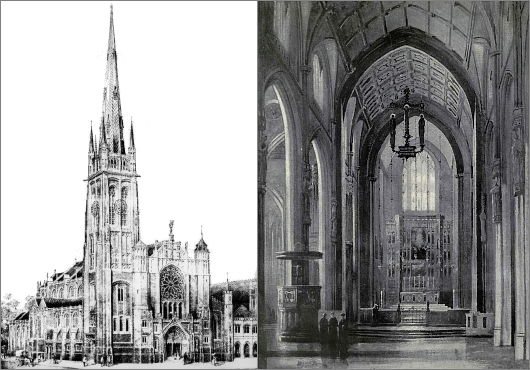
We rarely mention Johannesburg on this little corner of the web because our mother taught us that if you don’t have anything nice to say, don’t say anything at all. While ruffling through the archives the other day, however, I came across this design for the Johannesburg cathedral of the Church of the Province of South Africa. George Halford Fellowes Prynne (1853–1927) was an accomplished Gothic architect whose work is mostly found in the south of England. He’s notable for his rood screens in particular, worked in a variety of forms and materials (wood, stone, and metal), though this design employs a hanging rood. (more…)
Unbuilt St. Thomas
Lord & Hewlett’s Competition Entry for the Church of St. Thomas
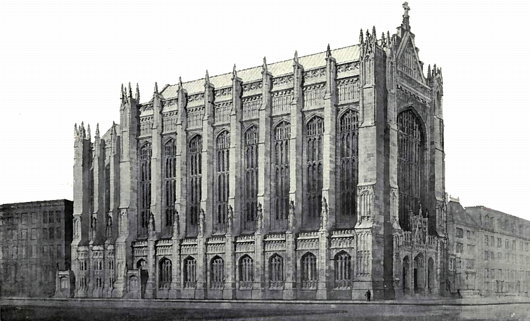
THE CHURCH OF Saint Thomas on the corner of Fifty-third Street and Fifth Avenue in New York is one of the artistic gems of the city: both as an architectural marvel designed by Ralph Adams Cram & Bertram Grosvenor Goodhue and as a musical paradise with its renowned choir of men & boys formerly under the tutelage of Gerre Hancock. (It’s foolish for anyone in the city during Advent to miss the Service of Lessons & Carols). The parish of the Episcopal Diocese of New York was established in 1834, and its first building was erected in the Gothic style on the corner of Broadway and Houston.
In 1870, after that neck of the woods became less fashionable, the congregation moved to its current location at 53rd & Fifth, to a new Gothic edifice by Richard Upjohn. That church hosted the marriage of Consuelo Vanderbilt to the 9th Duke of Marlborough. When it burned down in 1905, a competition was held to select the design of the new Church of St. Thomas, then perhaps at the peak of its high social status among Manhattan’s Protestant congregations. (more…)
‘The greatest and most successful pseudoscientific fraud I have seen in my long life’
Harold Lewis, eminent American physicist, resigns from learned society which has helped stifle the scientific debate over global warming
The physicist Harold Lewis has resigned from the American Physical Society over the learned group’s efforts to suppress scientific inquiry and debate into global warming and climate change. Prof. Lewis, who is Emeritus Professor of Physics at the University of California Santa Barbara, cited the leaked ‘ClimateGate’ e-mails as proof of scientific fraud. His resignation letter (reproduced below) speaks of ‘the money flood’ and alludes to President Eisenhower’s warning in his farewell address of 1961 to guard against ‘the unwarranted influence, whether sought or unsought, [of] the military-industrial complex’.
While he has refrained from coining the phrase, Prof. Lewis’s remarks suggests the massive amount of funding available for climate research has created a climate-industrial complex pressuring and perverting the scientific profession and leading it away from an environment of free inquiry.
“[T]he global warming scam, with the (literally) trillions of dollars driving it,” Prof. Lewis wrote, “has corrupted so many scientists, and has carried APS before it like a rogue wave. It is the greatest and most successful pseudoscientific fraud I have seen in my long life as a physicist.” (more…)
The End of the Antilles
The Netherlands Antilles is Dissolved
THIS MORNING, one  country disappeared, two more were born, a fourth was expanded, and all are part of a single kingdom. The Netherlands Antilles, the collective islands of the Dutch West Indies which since 1954 has formed a constituent country of the Kingdom of the Netherlands, was dissolved. Two of the islands in the archipelago, Curaçao and Sint Maarten, have become full constituent countries of the Kingdom (alongside Aruba, which was separated from the Antilles in 1986, and the Netherlands proper), while the islands of Bonaire, Sint Eustatius, and Saba (the ‘B.E.S.’ islands) have been merged into the Netherlands proper as special municipalities.
country disappeared, two more were born, a fourth was expanded, and all are part of a single kingdom. The Netherlands Antilles, the collective islands of the Dutch West Indies which since 1954 has formed a constituent country of the Kingdom of the Netherlands, was dissolved. Two of the islands in the archipelago, Curaçao and Sint Maarten, have become full constituent countries of the Kingdom (alongside Aruba, which was separated from the Antilles in 1986, and the Netherlands proper), while the islands of Bonaire, Sint Eustatius, and Saba (the ‘B.E.S.’ islands) have been merged into the Netherlands proper as special municipalities.
The government of North Holland has invited the B.E.S. islands to join the province, but this has not yet been agreed to. With a combined population of just 17,000, Bonaire, Sint Eustatius, and Saba do not have enough inhabitants to justify forming a single province of their own — the province with the lowest population at the moment is Flevoland at 356,000. North Holland’s offer may be turned down if it entails the complication of the three island-municipalities becoming part of the European Union. Currently all the islands of the Netherlands Antilles are outside the E.U., but all their citizens are E.U. citizens by virtue of being Dutch citizens. (more…)
Fated
WHETHER Parliament approves “therapeutic cloning” or not, will it make any difference in the long run? Whatever scientists can do, that will be done. Public opinion, at first aghast at artificial insemination and other landmarks on this infernal road, has largely come to accept them. So it is likely to be with this latest triumph.
 “Science has put into our hands innumerable gifts that we can use either for good or ill.” This mantra, once regularly intoned, has become less popular now that many of these gifts are plainly seen to be used for ill.
“Science has put into our hands innumerable gifts that we can use either for good or ill.” This mantra, once regularly intoned, has become less popular now that many of these gifts are plainly seen to be used for ill.
A new palliative has appeared instead: it says that we must be kept well informed about the latest scientific developments, as well as learning more about science and scientific methods, so that we can decide for ourselves whether we want these gifts or not.
But who are “we”? Would it make any difference if we said we did not want them? Would it make any difference if some scientists themselves decided they were too dangerous to proceed with? Others would somehow, somewhere, carry on the work. The progress of science and technology which has seized upon our world seems irreversible, even fated.
Will it, as in some environmentalist fantasy, gradually diminish in strength and become humanly manageable in a new, green and “sustainable” world? Or will it, as seems more likely, proceed to a catastrophic end?
Search
Instagram: @andcusack
Click here for my Instagram photos.Most Recent Posts
- Silver Jubilee November 21, 2024
- Articles of Note: 11 November 2024 November 11, 2024
- Why do you read? November 5, 2024
- India November 4, 2024
- The Lithe Efficiency of the Old Constitution November 4, 2024
Most Recent Comments
Book Wishlist
Monthly Archives
Categories


